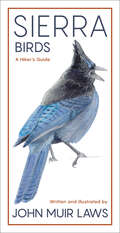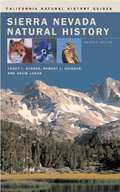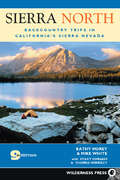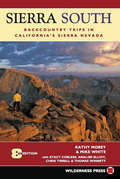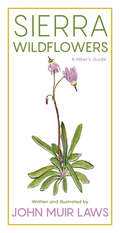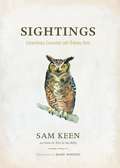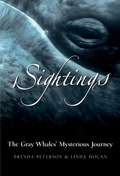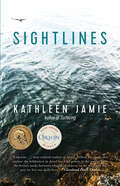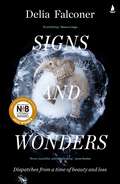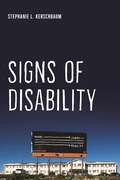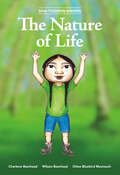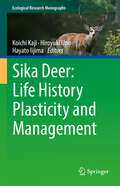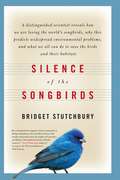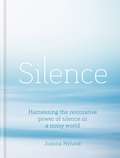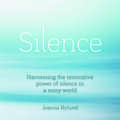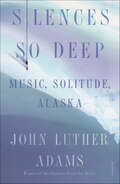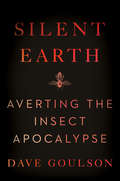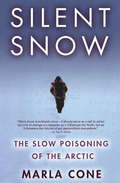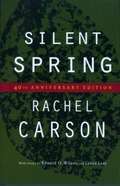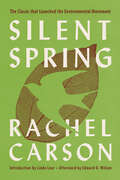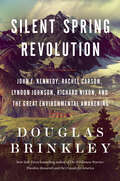- Table View
- List View
Sierra Birds: A Hiker's Guide
by John LawsOver 35,000 copies sold! As a naturalist managing the field studies program at the California Academy of Sciences, John Muir Laws noticed that novice birders often distinguish birds by color and size rather than species. This inspired him to create Sierra Birds: A Hiker's Guide, a unique book that assumes no prior birding knowledge on the part of the reader. Color-coded keys eliminate the time-consuming frustration of thumbing randomly through a guide, and a cross-index is also included for more advanced birders. All this in a format that is simply organized, lightweight, and small enough to tuck inside a pocket. A first-rate naturalist, Laws is also an accomplished artist. His illustrations are lively, colorful, and accurate, and drawn to represent species in the manner in which one generally sees them in the field.
Sierra Birds: A Hiker's Guide
by John Muir LawsThe beginner’s birding book that covers species found in the Sierra Nevada—from the author of The Law’s Guide to Nature Drawing and Journaling.As a naturalist managing the field studies program at the California Academy of Sciences, John Muir Laws noticed that novice birders often distinguish birds by color and size rather than species. This inspired him to create Sierra Birds: A Hiker’s Guide, a unique book that assumes no prior birding knowledge on the part of the reader. Color-coded keys eliminate the time-consuming frustration of thumbing randomly through a guide, and a cross-index is also included for more advanced birders. All this in a format that is simply organized and perfect to read on a smartphone or tablet. A first-rate naturalist, Laws is also an accomplished artist. His illustrations are lively, colorful, and accurate, and drawn to represent species in the manner in which one generally sees them in the field.Praise for John Muir Laws“For those of us who live in California, there are few resources that top the books by John Muir Laws. His Field Guide to the Sierra Nevada and his Pocket Guide to the San Francisco Bay Area combine beautiful illustrations with exacting biological information on birds, beasts, and plants.” —Sierra Magazine
Sierra Nevada Natural History (California Natural History Guide #73)
by Tom Taylor Bill Nelson Tracy I. Storer Robert L. Usinger David Lukas Phyllis M. Faber Peter Gaede John Gamel Bruce M. Pavlik Christopher Rogers<p>The magnificent and much-loved Sierra Nevada, called the "Range of Light" by John Muir, is the dominant feature on the California landscape. First published forty years ago, this handbook has become an enduring natural history classic, used by thousands to learn more about virtually every aspect of this spectacular mountain range―from its superb flora and fauna to its rugged topography. <p>Comprehensive yet concise and portable, the book describes hundreds of species: trees and shrubs, flowering plants and ferns, fungi and lichens, insects and fish, amphibians and reptiles, and birds and mammals. Now completely updated and revised, it will continue to be the essential guide to the Sierra Nevada for a new generation of hikers, campers, tourists, naturalists, students, and teachers―everyone who wants to know more about this unique and beautiful mountain range. </p>
Sierra North
by Mike White Thomas Winnett Stacey Corless Kathy MoreyNow in its 9th edition, the completely updated and revised Sierra North showcases new trips and old favorites in regions such as Desolation Wilderness, Emigrant Wilderness, the proposed Castle Peak Wilderness, and the world-famous Yosemite National Park.
Sierra South
by Mike White Thomas Winnett Stacey Corless Kathy Morey Chris Tirrell Analise Elliot HeidThis completely revised and updated 8th edition of Sierra South now covers an expanded region of the Sierra, from the southern boundary of Yosemite National Park to southern Golden Trout Wilderness. With new trips and old favorites, Sierra South is the classic guide to backpacking in Sequoia and Kings Canyon national parks, Ansel Adams Wilderness, and Mt. Whitney.
Sierra WildFlowers: A Hiker's Guide
by John LawsFrom sprawling fields of showy hillside poppies, lupines, and paintbrushes in the foothills to orchids, lilies, and primroses in the higher meadows of our national parks, the Sierra Nevada is one of the premier wildflower destinations in California. Naturalist John Muir Laws has adapted his painted-from-life flower illustrations from The Laws Field Guide to the Sierra Nevada into a lightweight yet durable guidebook to the area's florae. Sierra Wildflowers includes the most common species that you will encounter, with fully updated common and scientific names. Flowers are organized by color and shape, making identification easy for flower enthusiasts of all experience levels.
Sightings
by Sam Keen Mary WoodinSam Keen, the New York Times best-selling author of Fire in the Belly, has spent a lifetime reflecting on nature. In Sightings, a collection of essays, bird watching forms the basis for observations spiritual and soulful, witty and wise. He describes his childhood ramblings in the silence of the Tennessee wilderness as feeling distinctly more spiritual than the hard pews of his grandmother's church. Later in life, the presumed extinction and subsequent rediscovery of the Ivory-billed Woodpecker prompts a meditation on the nature of the sacred. Blessed with moments of beauty and the insight to recognize them as such, Keen translates the marvels of nature into the language of heart and soul.
Sightings: The Gray Whales' Mysterious Journey
by Linda Hogan Brenda PetersonTraces the lives of gray whales during their migrations between Alaska and Mexico, from their summer feeding grounds in the Bering Sea to winter birthing lagoons in Baja, examining their rich history including the conflict between their hunters and environmental protectors.
Sightlines: A Conversation with the Natural World
by Kathleen JamieWinner of the 2014 Orion Book Award for Nonfiction Winner of the John Burroughs Association 2014 Medal for Distinguished Natural History Book In Sightlines, Kathleen Jamie reports from the field—from her native Scottish “byways and hills” to the frigid Arctic in fourteen enthralling essays. She dissects whatever her gaze falls upon—vistas of cells beneath a hospital microscope, orcas rounding a headland, the aurora borealis lighting up the frozen sea. In so doing, she questions what, exactly, constitutes “nature,” and upends the idea that it is always picturesque. Written with precision, subtlety, and wry humor, Sightlines urges the reader: “Keep looking, even when there’s nothing much to see.”
Signs and Wonders: Dispatches from a time of beauty and loss
by Delia FalconerThe celebrated, Walkley Award-winning author on how global warming is changing not only our climate but our culture. Beautifully observed, brilliantly argued and deeply felt, these essays show that our emotions, our art, our relationships with the generations around us – all the delicate networks that make us who we are – have already been transformed. In Signs and Wonders, Falconer explores how it feels to live as a reader, a writer, a lover of nature and a mother of small children in an era of profound ecological change. Building on Falconer&’s two acclaimed essays, &‘Signs and Wonders&’ and the Walkley Award-winning &‘The Opposite of Glamour&’, Signs and Wonders is a pioneering examination of how we are changing our culture, language and imaginations along with our climate. Is a mammoth emerging from the permafrost beautiful or terrifying? How is our imagination affected when something that used to be ordinary – like a car windscreen smeared with insects – becomes unimaginable? What can the disappearance of the paragraph from much contemporary writing tell us about what&’s happening in the modern mind? Scientists write about a 'great acceleration' in human impact on the natural world. Signs and Wonders shows that we are also in a period of profound cultural acceleration, which is just as dynamic, strange, extreme and, sometimes, beautiful. Ranging from an &‘unnatural&’ history of coal to the effect of a large fur seal turning up in the park below her apartment, this book is a searching and poetic examination of the ways we are thinking about how, and why, to live now. &‘Only the finest of writers can hope to convey the mercurial nature of the times we are living though: the sense of slippage; of terror and beauty. Falconer is such a writer. Signs and Wonders is an essential collection.&’ Sophie Cunningham, author of City of Trees &‘Delia Falconer is one of the best writers working today, and in Signs and Wonders she demonstrates everything that makes her writing so necessary. Brave, beautiful, and breathtaking in its elegance and intelligence, it is, quite simply, a marvel.&’ James Bradley &‘Scintillating. Delia Falconer is at the peak of her powers as a critic, and as an observer of the natural world. Signs and Wonders looks outward from Sydney, and from literature, to trace the contours of our environmental moment.&’ Rebecca Giggs, author of Fathoms
Signs of Disability (Crip #4)
by Stephanie L. KerschbaumHow can we learn to notice the signs of disability?We see indications of disability everywhere: yellow diamond-shaped “deaf person in area” road signs, the telltale shapes of hearing aids, or white-tipped canes sweeping across footpaths. But even though the signs are ubiquitous, Stephanie L. Kerschbaum argues that disability may still not be perceived due to a process she terms “dis-attention.”To tell better stories of disability, this multidisciplinary work turns to rhetoric, communications, sociology, and phenomenology to understand the processes by which the material world becomes sensory input that then passes through perceptual apparatuses to materialize phenomena—including disability. By adding perception to the understanding of disability’s materialization, Kerschbaum significantly expands our understanding of disability, accounting for its fluctuations and transformations in the semiotics of everyday life.Drawing on a set of thirty-three research interviews focused on disabled faculty members’ experiences with disability disclosure, as well as written narratives by disabled people, this book argues for the materiality of narrative, suggesting narratives as a means by which people enact boundaries around phenomena and determine their properties. Signs of Disability offers strategies and practices for challenging problematic and pervasive forms of “dis-attention” and proposes a new theoretical model for understanding disability in social, rhetorical, and material settings.
Siha Tooskin Knows the Nature of Life (Siha Tooskin Knows)
by Charlene Bearhead Wilson BearheadPaul Wahasaypa knows that Ena Makoochay (Mother Earth) gives us many things. On this compelling nature journey with Ena (his mom), we learn how strength, generosity, kindness, and humility are all shown to us by grandfather rocks, towering trees, four-legged ones, and winged ones, reminding us of the part we have to play in this amazing creation. Join Paul and Ena as they experience the beautiful nature of life.The Siha Tooskin Knows series uses vivid narratives and dazzling illustrations in contemporary settings to share stories about an 11-year-old Nakota boy.
Siha Tooskin Knows the Nature of Life (Siha Tooskin Knows)
by Charlene Bearhead Wilson BearheadPaul Wahasaypa knows that Ena Makoochay (Mother Earth) gives us many things. On this compelling nature journey with Ena (his mom), we learn how strength, generosity, kindness, and humility are all shown to us by grandfather rocks, towering trees, four-legged ones, and winged ones, reminding us of the part we have to play in this amazing creation. Join Paul and Ena as they experience the beautiful nature of life.The Siha Tooskin Knows series uses vivid narratives and dazzling illustrations in contemporary settings to share stories about an 11-year-old Nakota boy.
Siha Tooskin Knows the Nature of Life (Siha Tooskin Knows)
by Charlene Bearhead Wilson BearheadPaul Wahasaypa knows that Ena Makoochay (Mother Earth) gives us many things. On this compelling nature journey with Ena (his mom), we learn how strength, generosity, kindness, and humility are all shown to us by grandfather rocks, towering trees, four-legged ones, and winged ones, reminding us of the part we have to play in this amazing creation. Join Paul and Ena as they experience the beautiful nature of life.The Siha Tooskin Knows series uses vivid narratives and dazzling illustrations in contemporary settings to share stories about an 11-year-old Nakota boy.
Sika Deer: Life History Plasticity and Management (Ecological Research Monographs)
by Koichi Kaji Hiroyuki Uno Hayato IijimaThis book provides complete and up-to-date information on sika deer biology and its management, focusing on their life history with an integrated approach of population dynamics, morphology, genetics, and evolution. The expanding distribution of sika and its increase in population in Japan and other countries are causing damage to agriculture and forestry, impacting ecosystems and affecting other species. We are facing conflicting deer issues regarding the conservation of resource values and pest control of sika deer. This contributed volume compiles new findings focusing on the ecological plasticity of the sika deer. It aims to clarify the ecological characteristics of the deer by integrating studies of different approaches and provides a perspective for their management. The book consists of six parts. Part I introduces the ecological and management background behind the history of sika deer. The following four parts discuss movement ecology (Part II), impact on vegetation and bottom-up effect on sika deer (Part III), impact on ecosystem and its resilience (Part IV), and comparison of life-history characteristics between sika deer and other ungulate species (Part V). The last part (Part VI) covers the science-based management of sika deer. Contributed by recognized experts and young researchers of sika deer, this book appeals to researchers and professionals in wildlife biology and wildlife management, evolution, population dynamics, morphology, genetics, and reproductive physiology.
Silence of the Songbirds
by Bridget StutchburySince 1970 the population of songbirds in the United States and Canada has fallen by 30 percent. From their winter homes in the neotropical rainforests to their breeding grounds in northern Canada songbirds face a host of hazards caused by human-made changes to the environment. The author explores the impact of deforestation, habitat fragmentation, pesticides, city lights, and marauding cats on songbird survival. She outlines steps we can take to save the songbirds before it is too late.
Silence: Harnessing the restorative power of silence in a noisy world
by Joanna NylundIn our increasingly frenetic, modern lives silence has become a treasured commodity. In an era of constant technological stimulation, moments of silence and reflection are harder to achieve than ever before. But what really is silence and what effect does it have on our wellbeing?In Silence, Joanna Nylund reflects on the cultural, scientific and spiritual impact of silence and the ways in which it has impacted our human history, whilst suggesting how we might be able to harness it's power to boost our health. With practical tips and techniques, Nylund demonstrates that integrating moments of silence into our everyday routine can boost creativity, increase communication and improve mental health. Silence shows us that moments of quiet are not to be feared but are windows of introspection to embraced and harnessed for our own personal development.
Silence: Harnessing the restorative power of silence in a noisy world
by Joanna NylundIn our increasingly frenetic, modern lives silence has become a treasured commodity. In an era of constant technological stimulation, moments of silence and reflection are harder to achieve than ever before. But what really is silence and what effect does it have on our wellbeing?In Silence, Joanna Nylund reflects on the cultural, scientific and spiritual impact of silence and the ways in which it has impacted our human history, whilst suggesting how we might be able to harness it's power to boost our health. With practical tips and techniques, Nylund demonstrates that integrating moments of silence into our everyday routine can boost creativity, increase communication and improve mental health. Silence shows us that moments of quiet are not to be feared but are windows of introspection to embraced and harnessed for our own personal development.
Silence: Harnessing the restorative power of silence in a noisy world
by Joanna NylundIn our increasingly frenetic, modern lives, silence has become a treasured commodity. In an era of constant technological stimulation, moments of silence and reflection are harder to achieve than ever before. But what really is silence and what effect does it have on our wellbeing?In Silence, Joanna Nylund reflects on the cultural, scientific and spiritual impact of silence and the ways in which it has impacted our human history, whilst suggesting how we might be able to harness it's power to boost our health. With practical tips and techniques Nylund demonstrates that integrating moments of silence into our everyday routine can increase creativity, improve communication and improve mental health. Silence shows us that moments of quiet are not to be feared but are windows of introspection to embraced and harnessed for our own personal development.(p) Octopus Publishing 2020
Silences So Deep: Music, Solitude, Alaska
by John Luther Adams"[An] illuminating memoir." —Corinna da Fonseca-Wollheim, The New York TimesThe story of a composer's life in the Alaskan wilderness and a meditation on making art in a landscape acutely threatened by climate changeIn the summer of 1975, the composer John Luther Adams, then a twenty-two-year-old graduate of CalArts, boarded a flight to Alaska. So began a journey into the mountains, forests, and tundra of the far north—and across distinctive mental and aural terrain—that would last for the next forty years. Silences So Deep is Adams’s account of these formative decades—and of what it’s like to live alone in the frozen woods, composing music by day and spending one’s evenings with a raucous crew of poets, philosophers, and fishermen. From adolescent loves—Edgard Varèse and Frank Zappa—to mature preoccupations with the natural world that inform such works as The Wind in High Places, Adams details the influences that have allowed him to emerge as one of the most celebrated and recognizable composers of our time. Silences So Deep is also a memoir of solitude enriched by friendships with the likes of the conductor Gordon Wright and the poet John Haines, both of whom had a singular impact on Adams’s life. Whether describing the travails of environmental activism in the midst of an oil boom or midwinter conversations in a communal sauna, Adams writes with a voice both playful and meditative, one that evokes the particular beauty of the Alaskan landscape and the people who call it home.Ultimately, this book is also the story of Adams’s difficult decision to leave a rapidly warming Alaska and to strike out for new topographies and sources of inspiration. In its attentiveness to the challenges of life in the wilderness, to the demands of making art in an age of climate crisis, and to the pleasures of intellectual fellowship, Silences So Deep is a singularly rich account of a creative life.
Silent Earth: Averting the Insect Apocalypse
by Dave Goulson“A terrific book…A thoughtful explanation of how the dramatic decline of insect species and numbers poses a dire threat to all life on earth.” (Booklist, Starred Review)In the tradition of Rachel Carson’s groundbreaking environmental classic Silent Spring, an award-winning entomologist and conservationist explains the importance of insects to our survival, and offers a clarion call to avoid a looming ecological disaster of our own making.Drawing on thirty years of research, Goulson has written an accessible, fascinating, and important book that examines the evidence of an alarming drop in insect numbers around the world. “If we lose the insects, then everything is going to collapse,” he warned in a recent interview in the New York Times—beginning with humans’ food supply. The main cause of this decrease in insect populations is the indiscriminate use of chemical pesticides. Hence, Silent Earth’s nod to Rachel Carson’s classic Silent Spring which, when published in 1962, led to the global banning of DDT. This was a huge victory for science and ecological health at the time.Yet before long, new pesticides just as lethal as DDT were introduced, and today, humanity finds itself on the brink of a new crisis. What will happen when the bugs are all gone? Goulson explores the intrinsic connection between climate change, nature, wildlife, and the shrinking biodiversity and analyzes the harmful impact for the earth and its inhabitants. Meanwhile we have all read stories about hive collapse syndrome affecting honeybee colonies and the tragic decline of monarch butterflies in North America, and more. But it is not too late to arrest this decline, and Silent Earth should be the clarion call. Smart, eye-opening, and essential, Silent Earth is a forceful call to action to save our world, and ultimately, ourselves.Silent Earth includes approximately 20 black-and-white illustrations and charts and graphs.
Silent Snow: The Slow Poisoning of the Arctic
by Marla Cone&“A slender but punch-packing overview of the environmental destruction of the Far North&” from the award-winning environmental reporter (Kirkus Reviews). Traditionally thought of as the last great unspoiled territory on Earth, the Arctic is in reality home to some of the most severe contamination on the planet. Awarded a major grant by the Pew Charitable Trusts to study the Arctic&’s deteriorating environment, Los Angeles Times environmental reporter Marla Cone traveled across the Far North, from Greenland to the Aleutian Islands, to find out why the Arctic has become so toxic. Silent Snow is not only a scientific journey, but a personal one with experiences that range from tracking endangered polar bears in Norway to hunting giant bowhead whales with native Alaskans struggling to protect their livelihood. Through it all, Cone reports with heartbreaking immediacy on the dangers of pollution to native peoples and ecosystems, how Arctic cultures are adapting to this pollution, and what solutions will prevent the crisis from getting worse.
Silent Spring (40th anniversary edition)
by Rachel CarsonSilent Spring became a runaway bestseller, with international reverberations . . . [It is] well crafted, fearless and succinct . . . Even if she had not inspired a generation of activists, Carson would prevail as one of the greatest nature writers in American letters" (Peter Matthiessen, for Time"s 100 Most Influential People of the Century). This fortieth anniversary edition celebrates Rachel Carson"s watershed book with a new introduction by the author and activist Terry Tempest Williams and a new afterword by the acclaimed Rachel Carson biographer Linda Lear, who tells the story of Carson"s courageous defense of her truths in the face of ruthless assault from the chemical industry in the year following the publication of Silent Spring and before her untimely death in 1964.
Silent Spring (Pelican Ser.)
by Rachel Carson Edward O. Wilson Linda LearRachel Carson's Silent Spring was first published in three serialized excerpts in the New Yorker in June of 1962. The book appeared in September of that year and the outcry that followed its publication forced the banning of DDT and spurred revolutionary changes in the laws affecting our air, land, and water. Carson's passionate concern for the future of our planet reverberated powerfully throughout the world, and her eloquent book was instrumental in launching the environmental movement. It is without question one of the landmark books of the twentieth century.
Silent Spring Revolution: John F. Kennedy, Rachel Carson, Lyndon Johnson, Richard Nixon, and the Great Environmental Awakening
by Douglas BrinkleyNew York Times bestselling author and acclaimed presidential historian Douglas Brinkley chronicles the rise of environmental activism during the Long Sixties (1960-1973), telling the story of an indomitable generation that saved the natural world under the leadership of John F. Kennedy, Lyndon Johnson, and Richard Nixon.With the detonation of the Trinity explosion in the New Mexico desert in 1945, the United States took control of Earth’s destiny for the first time. After the Truman administration dropped atomic bombs on Japan to end World War II, a grim new epoch had arrived. During the early Cold War years, the federal government routinely detonated nuclear devices in the Nevada desert and the Marshall Islands. Not only was nuclear fallout a public health menace, but entire ecosystems were contaminated with radioactive materials. During the 1950s, an unprecedented postwar economic boom took hold, with America becoming the world’s leading hyperindustrial and military giant. But with this historic prosperity came a heavy cost: oceans began to die, wilderness vanished, the insecticide DDT poisoned ecosystems, wildlife perished, and chronic smog blighted major cities. In Silent Spring Revolution, Douglas Brinkley pays tribute to those who combated the mauling of the natural world in the Long Sixties: Rachel Carson (a marine biologist and author), David Brower (director of the Sierra Club), Barry Commoner (an environmental justice advocate), Coretta Scott King (an antinuclear activist), Stewart Udall (the secretary of the interior), William O. Douglas (Supreme Court justice), Cesar Chavez (a labor organizer), and other crusaders are profiled with verve and insight. Carson’s book Silent Spring, published in 1962, depicted how detrimental DDT was to living creatures. The exposé launched an ecological revolution that inspired such landmark legislation as the Wilderness Act (1964), the Clean Air Acts (1963 and 1970), and the Endangered Species Acts (1966, 1969, and 1973). In intimate detail, Brinkley extrapolates on such epic events as the Donora (Pennsylvania) smog incident, JFK’s Limited Nuclear Test Ban Treaty, Great Lakes preservation, the Santa Barbara oil spill, and the first Earth Day.With the United States grappling with climate change and resource exhaustion, Douglas Brinkley’s meticulously researched and deftly written Silent Spring Revolution reminds us that a new generation of twenty-first-century environmentalists can save the planet from ruin.Silent Spring Revolution features two 8-page color photo inserts.
